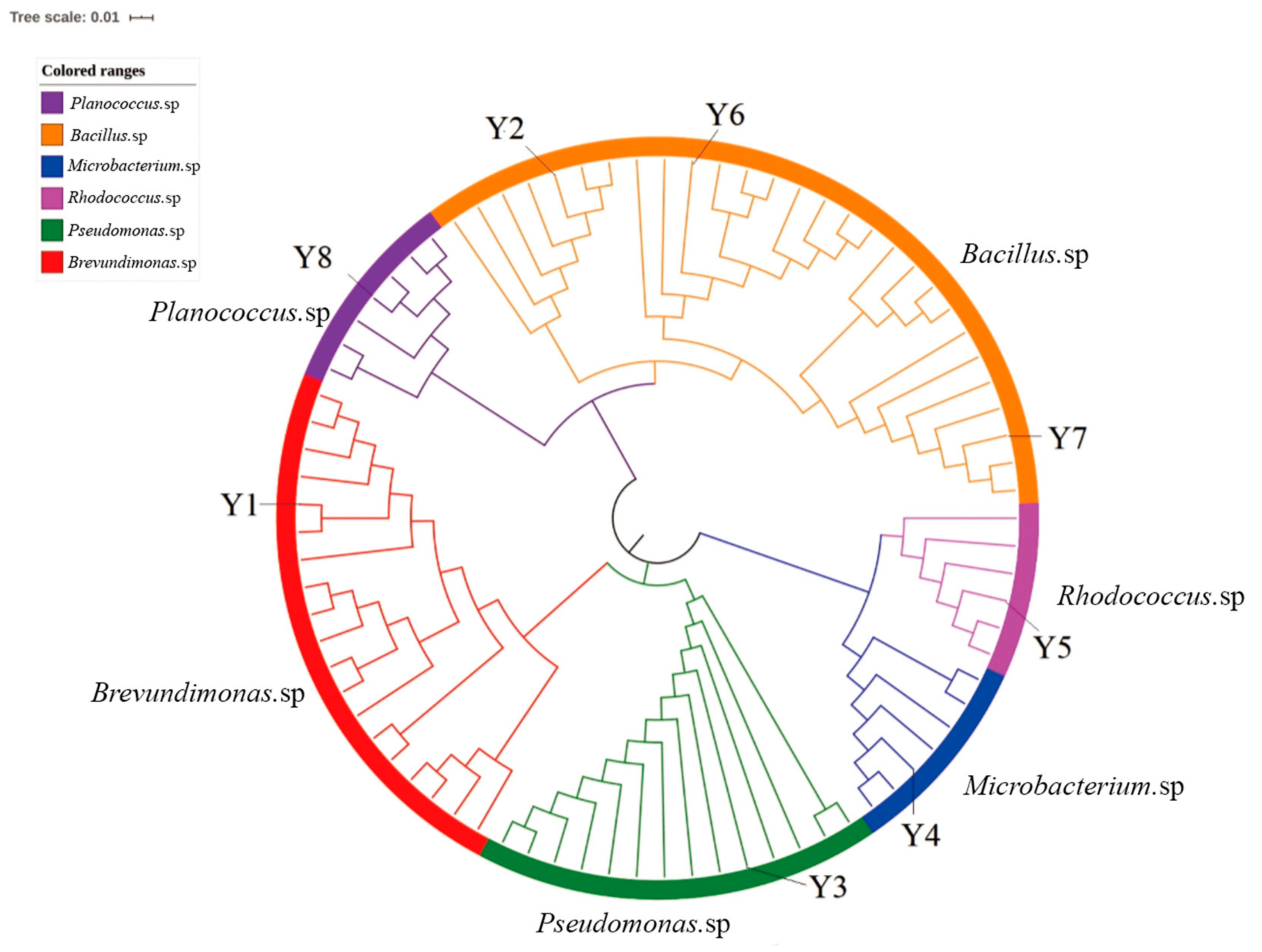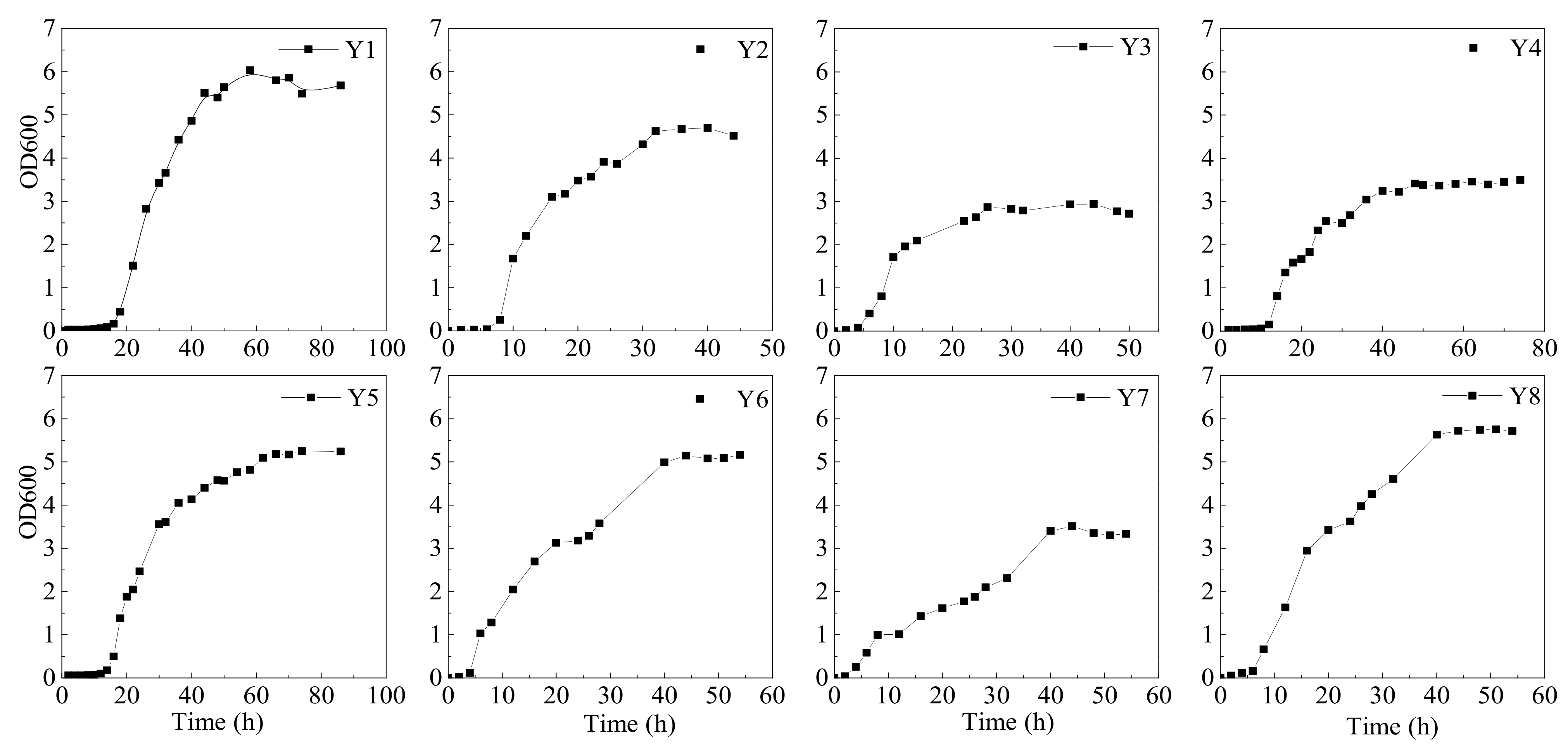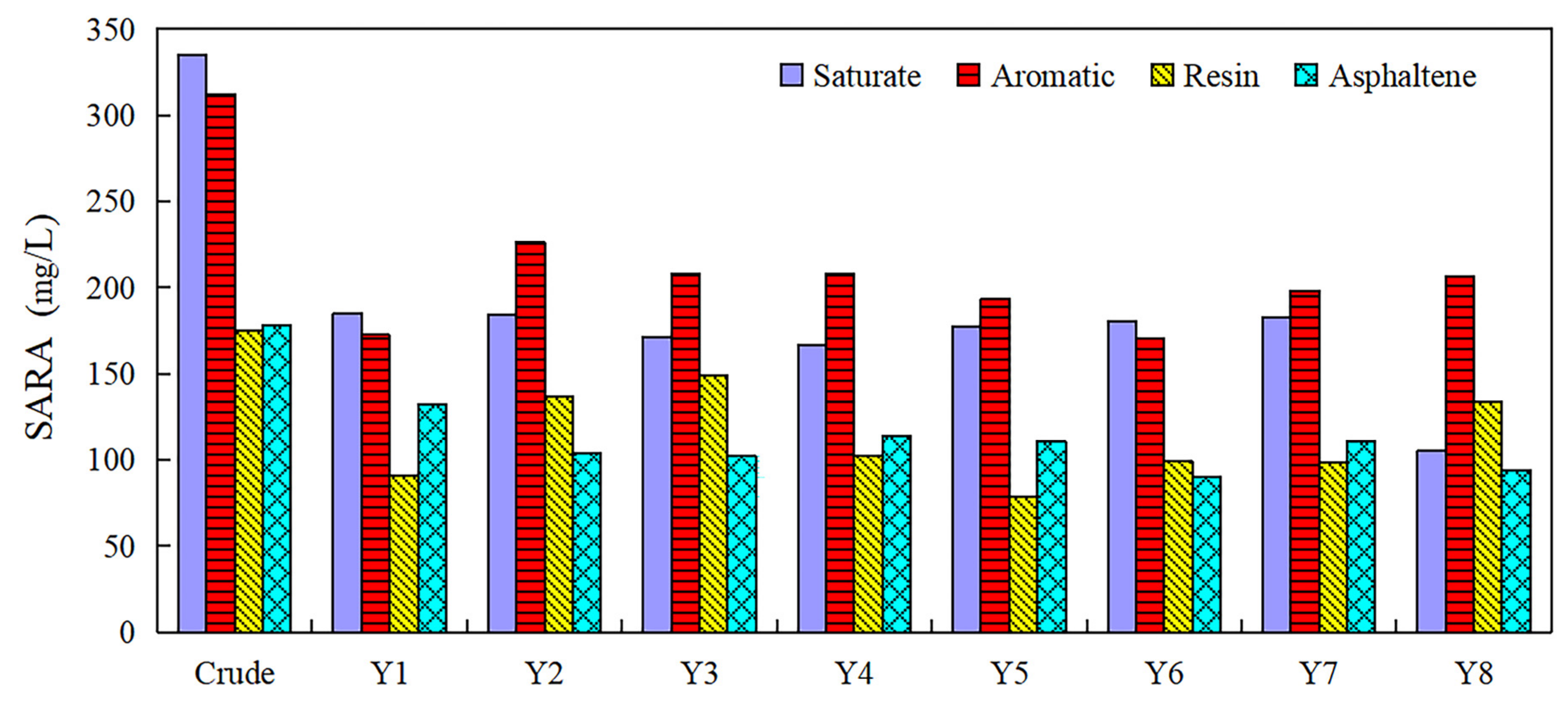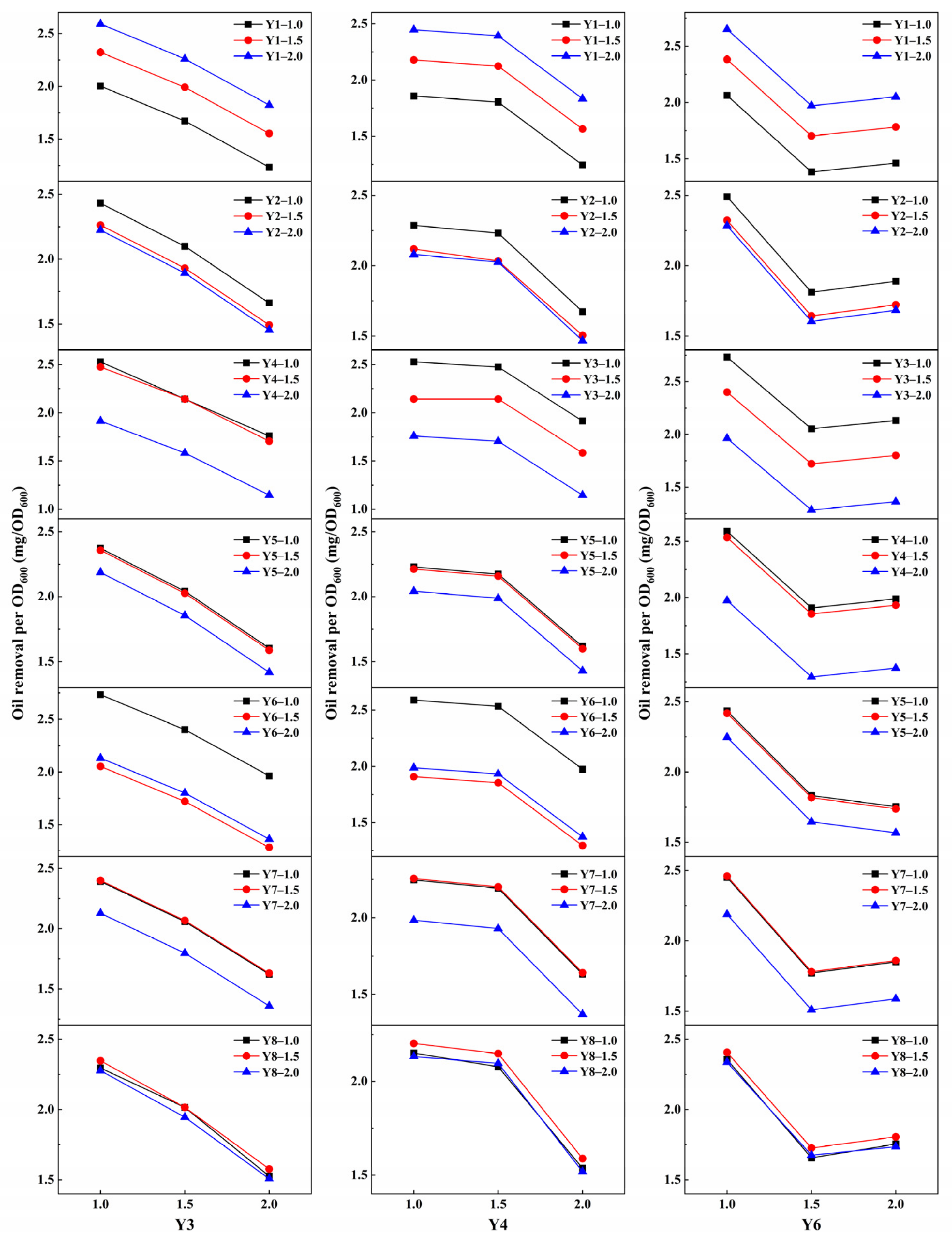Establishing and Optimizing a Bacterial Consortia for Effective Biodegradation of Petroleum Contaminants: Advancing Classical Microbiology via Experimental and Mathematical Approach
Abstract
:1. Introduction
2. Materials and Methods
2.1. Bacteria Isolation and Culture Medium
2.2. Identification of Isolates
2.3. Bacterial Growth Curves and Oil Degradation
2.4. Establishing Bacterial Consortia in an Orthogonal Experiment
2.5. Mathematical Analysis of Microbial Interspecific Relationship
3. Results and Discussion
3.1. Bacteria Isolation and Identification
3.2. Bacterial Growth Curves and Oil Degradation
3.3. Oil Degradation in an Orthogonal Experiment for Consortia Establishment
3.4. Interspecific Relationship Analysis
3.5. Optimization of Petroleaum-Degrading Consortium
4. Conclusions
Supplementary Materials
Author Contributions
Funding
Institutional Review Board Statement
Informed Consent Statement
Data Availability Statement
Acknowledgments
Conflicts of Interest
References
- Kvenvolden, K.A.; Cooper, C.K. Natural Seepage of Crude Oil into the Marine Environment. Geo Marine Lett. 2003, 23, 140–146. [Google Scholar] [CrossRef]
- Du, W.; Wan, Y.; Zhong, N.; Fei, J.; Zhang, Z.; Chen, L.; Hao, J. Status Quo of Soil Petroleum Contamination and Evolution of Bioremediation. Pet. Sci. 2011, 8, 502–514. [Google Scholar] [CrossRef] [Green Version]
- Hussain, F.; Hussain, I.; Khan, A.H.A.; Muhammad, Y.S.; Iqbal, M.; Soja, G.; Reichenauer, T.G.; Zeshan; Yousaf, S. Combined Application of Biochar, Compost, and Bacterial Consortia with Italian Ryegrass Enhanced Phytoremediation of Petroleum Hydrocarbon Contaminated Soil. Environ. Exp. Bot. 2018, 153, 80–88. [Google Scholar] [CrossRef]
- Lovely, D.R. Cleaning Up with Genomics: Application of Molecular Biology to Bioremediation. Soil Sediment Contam. 2004, 13, 193–194. [Google Scholar] [CrossRef]
- Gao, J.; Ming, J.; Xu, M.; Fu, X.; Duan, L.-F.; Xu, C.-C.; Gao, Y.; Xue, J.-L.; Xiao, X.-F. Isolation and Characterization of a High-Efficiency Marine Diesel Oil-Degrading Bacterium. Pet. Sci. 2021, 18, 641–653. [Google Scholar] [CrossRef]
- Eze, M. Metagenome Analysis of a Hydrocarbon-Degrading Bacterial Consortium Reveals the Specific Roles of BTEX Biodegraders. Genes 2021, 12, 98. [Google Scholar] [CrossRef]
- Shi, K.; Zhang, Q.; Xue, J.; Chen, X.; Chen, Y.; Qiao, Y.; Yang, Y.; Sun, J. Study on the Degradation Performance and Bacterial Community of Bioaugmentation in Petroleum-Pollution Seawater. J. Environ. Chem. Eng. 2020, 8, 103900. [Google Scholar] [CrossRef]
- Al-Saleh, E.; Drobiova, H.; Obuekwe, C. Predominant Culturable Crude Oil-Degrading Bacteria in the Coast of Kuwait. Int. Biodeterior. Biodegrad. 2009, 63, 400–406. [Google Scholar] [CrossRef]
- Crisafi, F.; Giuliano, L.; Yakimov, M.M.; Azzaro, M.; Denaro, R. Isolation and Degradation Potential of a Cold-Adapted Oil/PAH-Degrading Marine Bacterial Consortium from Kongsfjorden (Arctic Region). Rend. Lince 2016, 27, 261–270. [Google Scholar] [CrossRef]
- Pramila, M.; Manikandan, S.; Anju, K.; Kannan, M.M.; Hong, S.; Maruthamuthu, S.; Subramanian, K. Electrochemical Decolorization and Degradation of Turquoise Blue G (TBG) by Pre-Adapted Petroleum Degrading Bacteria. Sep. Purif. Technol. 2014, 132, 719–727. [Google Scholar] [CrossRef]
- Rajasekar, A.; Anandkumar, B.; Maruthamuthu, S.; Ting, Y.-P.; Rahman, P.K.S.M. Characterization of Corrosive Bacterial Consortia Isolated from Petroleum-Product-Transporting Pipelines. Appl. Microbiol. Biotechnol. 2009, 85, 1175–1188. [Google Scholar] [CrossRef]
- Herrero, M.; Stuckey, D.C. Bioaugmentation and its Application in Wastewater Treatment: A Review. Chemosphere 2015, 140, 119–128. [Google Scholar] [CrossRef]
- Ma, M.; Zheng, L.; Yin, X.; Gao, W.; Han, B.; Li, Q.; Zhu, A.; Chen, H.; Yang, H. Reconstruction and Evaluation of Oil-Degrading Consortia Isolated from Sediments of Hydrothermal Vents in the South Mid-Atlantic Ridge. Sci. Rep. 2021, 11, 1456. [Google Scholar] [CrossRef]
- Al-Kindi, S.; Abed, R.M.M. Effect of Biostimulation Using Sewage Sludge, Soybean Meal, and Wheat Straw on Oil Degradation and Bacterial Community Composition in a Contaminated Desert Soil. Front. Microbiol. 2016, 7, 240. [Google Scholar] [CrossRef] [Green Version]
- Gurav, R.; Lyu, H.; Ma, J.; Tang, J.; Liu, Q.; Zhang, H. Degradation of N-Alkanes and PAHs from the Heavy Crude Oil Using Salt-Tolerant Bacterial Consortia and Analysis Catabolic Genes. Environ. Sci. Pollut. Res. 2017, 24, 11392–11403. [Google Scholar] [CrossRef]
- M’Rassi, A.G.; Bensalah, F.; Gury, J.; Duran, R. Isolation and Characterization of Different Bacterial Strains for Bioremediation of N-Alkanes and Polycyclic Aromatic Hydrocarbons. Environ. Sci. Pollut. Res. 2015, 22, 15332–15346. [Google Scholar] [CrossRef]
- Chandra, R.; Bharagava, R.N.; Kapley, A.; Purohit, H.J. Isolation and Characterization of Potential Aerobic Bacteria Capable for Pyridine Degradation in Presence of Picoline, Phenol and Formaldehyde as Co-Pollutants. World J. Microbiol. Biotechnol. 2009, 25, 2113–2119. [Google Scholar] [CrossRef]
- Kato, S.; Haruta, S.; Cui, Z.J.; Ishii, M.; Igarashi, Y. Stable Coexistence of Five Bacterial Strains as a Cellulose-Degrading Community. Appl. Environ. Microbiol. 2005, 71, 7099–7106. [Google Scholar] [CrossRef] [Green Version]
- Mikesková, H.; Novotný, Č.; Svobodová, K. Interspecific Interactions in Mixed Microbial Cultures in a Biodegradation Perspective. Appl. Microbiol. Biotechnol. 2012, 95, 861–870. [Google Scholar] [CrossRef]
- Dai, X.; Lv, J.; Yan, G.; Chen, C.; Guo, S.; Fu, P. Bioremediation of Intertidal Zones Polluted by Heavy Oil Spilling Using Immobilized Laccase-Bacteria Consortium. Bioresour. Technol. 2020, 309, 123305. [Google Scholar] [CrossRef]
- Hussain, F.; Tahseen, R.; Arslan, M.; Iqbal, S.; Afzal, M. Removal of Hexadecane by Hydroponic Root Mats in Partnership with Alkane-Degrading Bacteria: Bacterial Augmentation Enhances System’s Performance. Int. J. Environ. Sci. Technol. 2019, 16, 4611–4620. [Google Scholar] [CrossRef]
- Shabir, G.; Arslan, M.; Fatima, K.; Amin, I.; Khan, Q.M.; Afzal, M. Effects of Inoculum Density on Plant Growth and Hydrocarbon Degradation. Pedosphere 2016, 26, 774–778. [Google Scholar] [CrossRef]
- Jin, D.F.; Hu, H.; Liu, D.F.; Ding, H.T.; Jia, X.M.; Zhao, Y.H. Optimization of a Bacterial Consortium for Nitrobenzene Degradation. Water Sci. Technol. 2012, 65, 795–801. [Google Scholar] [CrossRef]
- Zaroual, Z.; Chaair, H.; Essadki, A.; El Ass, K.; Azzi, M. Optimizing the Removal of Trivalent Chromium by Electrocoagulation Using Experimental Design. Chem. Eng. J. 2009, 148, 488–495. [Google Scholar] [CrossRef]
- Zhao, C.; Wen, D.; Zhang, Y.; Zhang, J.; Tang, X. Experimental and Mathematical Methodology on the Optimization of Bacterial Consortium for the Simultaneous Degradation of Three Nitrogen Heterocyclic Compounds. Environ. Sci. Technol. 2012, 46, 6205–6213. [Google Scholar] [CrossRef]
- Wang, J.; Yan, G.; An, M.; Liu, J.; Zhang, H.; Chen, Y. Study of a Plugging Microbial Consortium using Crude Oil as Sole Carbon Source. Pet. Sci. 2008, 5, 367–374. [Google Scholar] [CrossRef] [Green Version]
- Dong, X.Z.; Cai, M.Y. Identification Manual of Systematic Bacteriology; Science Press: Beijing, China, 2001; pp. 364–398. [Google Scholar]
- Coico, R. Gram Staining. Curr. Protoc. Microbiol. 2006, 3, A–3C. [Google Scholar] [CrossRef]
- Cowan, S.T. Micromethod for the Methyl Red Test. J. Gen. Microbiol. 1953, 9, 101–109. [Google Scholar] [CrossRef] [Green Version]
- Dunican, L.K.; Seeley, H.W. Starch Hydrolysis by Streptococcus Equinus. J. Bacteriol. 1962, 83, 264–269. [Google Scholar] [CrossRef] [Green Version]
- Simmons, J.S. A Culture Medium for Differentiating Organisms of Typhoid-Colon Aerogenes Groups and for Isolation of Certain Fungi. J. Infect. Disease 1926, 39, 209–214. Available online: http://www.jstor.org/stable/30083347 (accessed on 15 June 2021). [CrossRef]
- McDade, J.J.; Weaver, R.H. Rapid Methods for the Detection of Gelatin Hydrolysis. J. Bacteriol. 1959, 77, 60–64. [Google Scholar] [CrossRef] [PubMed] [Green Version]
- Taylor, W.I.; Achanzar, D. Catalase Test as an Aid to the Identification of Enterobacteriaceae. Appl. Microbiol. 1972, 24, 58–61. [Google Scholar] [CrossRef] [PubMed]
- Simon, E.; Hoffmann, J. Extraction of High Molecular Weight DNA from Molluscs. Trends Genet. 1993, 9, 407. [Google Scholar] [CrossRef]
- Cappello, S.; Russo, D.; Santisi, S.; Calogero, R.; Gertler, C.; Crisafi, F.; De Domenico, M.; Yakimov, M.M. Presence of Hydrocarbon-Degrading Bacteria in the Gills of Mussel Mytilus Galloprovincialis in a Contaminated Environment: A Mesoscale Simulation Study. Chem. Ecol. 2012, 28, 239–252. [Google Scholar] [CrossRef]
- Altschul, S.F.; Gish, W.; Miller, W.; Myers, E.W.; Lipman, D.J. Basic Local Alignment Search Tool. J. Mol. Biol. 1990, 215, 403–410. [Google Scholar] [CrossRef]
- Tamura, K.; Peterson, D.S.; Peterson, N.; Stecher, G.; Nei, M.; Kumar, S. MEGA5: Molecular Evolutionary Genetics Analysis Using Maximum Likelihood, Evolutionary Distance, and Maximum Parsimony Methods. Mol. Biol. Evol. 2011, 28, 2731–2739. [Google Scholar] [CrossRef] [Green Version]
- Gai, H.; Zhang, X.; Chen, S.; Wang, C.; Xiao, M.; Huang, T.; Wang, J.; Song, H. An Improved Tar–Water Separation Process of Low–Rank Coal Conversion Wastewater for Increasing the Tar Yield and Reducing the Oil Content in Wastewater. Chem. Eng. J. 2020, 383, 123229. [Google Scholar] [CrossRef]
- Lin, B.; Wang, J.; Huang, Q.; Chi, Y. Effects of Potassium Hydroxide on the Catalytic Pyrolysis of Oily Sludge for High-Quality Oil Product. Fuel 2017, 200, 124–133. [Google Scholar] [CrossRef]
- Nueda, M.J.; Conesa, A.; Westerhuis, J.A.; Hoefsloot, H.C.J.; Smilde, A.K.; Talón, M.; Ferrer, A. Discovering Gene Expression Patterns in Time Course Microarray Experiments by ANOVA–SCA. Bioinformatics 2007, 23, 1792–1800. [Google Scholar] [CrossRef] [Green Version]
- Mahjoubi, M.; Jaouani, A.; Guesmi, A.; Ben Amor, S.; Jouini, A.; Cherif, H.; Najjari, A.; Boudabous, A.; Koubaa, N.; Cherif, A. Hydrocarbonoclastic Bacteria Isolated from Petroleum Contaminated Sites in Tunisia: Isolation, Identification and Characterization of the Biotechnological Potential. New Biotechnol. 2013, 30, 723–733. [Google Scholar] [CrossRef]
- Schippers, A.; Bosecker, K.; Spröer, C.; Schumann, P. Microbacterium oleivorans sp. nov. and Microbacterium hydrocarbonoxydans sp. nov., Novel Crude-Oil-Degrading Gram-Positive Bacteria. Int. J. Syst. Evol. Microbiol. 2005, 55, 655–660. [Google Scholar] [CrossRef] [Green Version]
- Li, H.; Liu, Y.H.; Luo, N.; Zhang, X.Y.; Luan, T.G.; Hu, J.M.; Wang, Z.Y.; Wu, P.C.; Chen, M.J.; Lu, J.Q. Biodegradation of Benzene and its Derivatives by a Psychrotolerant and Moderately Haloalkaliphilic Planococcus sp. Strain ZD22. Res. Microbiol. 2006, 157, 629–636. [Google Scholar] [CrossRef]
- Obafemi, Y.; Taiwo, O.S.; Omodara, O.J.; Dahunsi, O.S.; Oranusi, S. Biodegradation of Crude Petroleum by Bacterial Consortia from Oil-Contaminated Soils in Ota, Ogun State, South-Western, Nigeria. Environ. Technol. Innov. 2018, 12, 230–242. [Google Scholar] [CrossRef] [Green Version]
- Wang, X.; Wang, X.; Liu, M.; Zhou, L.; Gu, Z.; Zhao, J. Bioremediation of Marine Oil Pollution by Brevundimonas diminuta: Effect of Salinity and Nutrients. Desalination Water Treat. 2015, 57, 19768–19775. [Google Scholar] [CrossRef]
- Pacwa-Płociniczak, M.; Czapla, J.; Płociniczak, T.; Piotrowska-Seget, Z. The Effect of Bioaugmentation of Petroleum-Contaminated Soil with Rhodococcus Erythropolis Strains on Removal of Petroleum from Soil. Ecotoxicol. Environ. Saf. 2019, 169, 615–622. [Google Scholar] [CrossRef]
- Beškoski, V.P.; Gojgic-Cvijovic, G.; Ilic, M.; Miletic, S.; Šolević, T.; Vrvic, M. Ex Situ Bioremediation of a Soil Contaminated by Mazut (Heavy Residual Fuel Oil)—A Field Experiment. Chemosphere 2011, 83, 34–40. [Google Scholar] [CrossRef]
- Wang, J.N.; Shi, Y.Y.; Zheng, L.Y.; Wang, Z.; Cai, Z.; Liu, J. Isolation and Identification of Petroleum Degradation Bacteria and Interspecific Interactions among Four Bacillus Strains. Environ. Sci. 2015, 36, 2245–2251. [Google Scholar] [CrossRef]
- Diallo, M.; Vural, C.; Cay, H.; Ozdemir, G. Enhanced Biodegradation of Crude Oil in Soil by a Developed Bacterial Consortium and Indigenous Plant Growth Promoting Bacteria. J. Appl. Microbiol. 2021, 130, 1192–1207. [Google Scholar] [CrossRef]
- Schink, B. Synergistic Interactions in the Microbial World. Antonie van Leeuwenhoek 2002, 81, 257–261. [Google Scholar] [CrossRef] [Green Version]
- Islam, M.A.; Karim, A.; Mishra, P.; Dubowski, J.J.; Yousuf, A.; Sarmin, S.; Khan, M.R. Microbial Synergistic Interactions Enhanced Power Generation in Co-Culture Driven Microbial Fuel Cell. Sci. Total. Environ. 2020, 738, 140138. [Google Scholar] [CrossRef]





| Isolate | Accession Number | Closest Hit | Identity (%) |
|---|---|---|---|
| Y1 | MT323225 | Brevundimonas sp. strain Tibet-IX23 (DQ177489.1) | 99.92 |
| Y2 | MT323226 | Bacillus firmus strain YHSA15 (KU744851.1) | 100 |
| Y3 | MT323223 | Pseudomonas alcaligenes strain NBRC (JX867714.1) | 100 |
| Y4 | MT323227 | Microbacterium oxydans strain CV8.4 (MN073508.1) | 100 |
| Y5 | MT323228 | Rhodococcus erythropolis strain SBUG 2052 (KU663053.1) | 99.85 |
| Y6 | MT323229 | Bacillus cereus strain MTCC 9817 (FJ841975.1) | 99.34 |
| Y7 | MT323230 | Bacillus aquimaris strain AT8 (MG547952.1) | 99.41 |
| Y8 | MT323231 | Planococcus sp. Tibet-IX21 (DQ177487.2) | 99.41 |
| Constructed Consortium | Inoculation Volume (mL) | Oil Degradation a (mg/mL OD600) | |||||||
|---|---|---|---|---|---|---|---|---|---|
| Y1 | Y2 | Y3 | Y4 | Y5 | Y6 | Y7 | Y8 | ||
| C1 | 1.00 | 1.00 | 1.00 | 1.00 | 1.00 | 1.00 | 1.00 | 1.00 | 3.0781 |
| C2 | 1.00 | 1.00 | 1.00 | 1.00 | 1.50 | 1.50 | 1.50 | 1.50 | 2.2875 |
| C3 | 1.00 | 1.00 | 1.00 | 1.00 | 2.00 | 2.00 | 2.00 | 2.00 | 1.6875 |
| C4 | 1.00 | 1.50 | 1.50 | 1.50 | 1.00 | 1.00 | 1.00 | 1.50 | 2.4625 |
| C5 | 1.00 | 1.50 | 1.50 | 1.50 | 1.50 | 1.50 | 1.50 | 2.00 | 2.1875 |
| C6 | 1.00 | 1.50 | 1.50 | 1.50 | 2.00 | 2.00 | 2.00 | 1.00 | 0.7400 |
| C7 | 1.00 | 2.00 | 2.00 | 2.00 | 1.00 | 1.00 | 1.00 | 2.00 | 1.1042 |
| C8 | 1.00 | 2.00 | 2.00 | 2.00 | 1.50 | 1.50 | 1.50 | 1.00 | 0.1100 |
| C9 | 1.00 | 2.00 | 2.00 | 2.00 | 2.00 | 2.00 | 2.00 | 1.50 | 1.0690 |
| C10 | 1.50 | 1.00 | 1.50 | 2.00 | 1.00 | 1.50 | 2.00 | 1.00 | 1.4565 |
| C11 | 1.50 | 1.00 | 1.50 | 2.00 | 1.50 | 2.00 | 1.00 | 1.50 | 1.2604 |
| C12 | 1.50 | 1.00 | 1.50 | 2.00 | 2.00 | 1.00 | 1.50 | 2.00 | 2.4600 |
| C13 | 1.50 | 1.50 | 2.00 | 1.00 | 1.00 | 1.50 | 2.00 | 1.50 | 1.2917 |
| C14 | 1.50 | 1.50 | 2.00 | 1.00 | 1.50 | 2.00 | 1.00 | 2.00 | 1.9300 |
| C15 | 1.50 | 1.50 | 2.00 | 1.00 | 2.00 | 1.00 | 1.50 | 1.00 | 1.9783 |
| C16 | 1.50 | 2.00 | 1.00 | 1.50 | 1.00 | 1.50 | 2.00 | 2.00 | 2.0300 |
| C17 | 1.50 | 2.00 | 1.00 | 1.50 | 1.50 | 2.00 | 1.00 | 1.00 | 2.5652 |
| C18 | 1.50 | 2.00 | 1.00 | 1.50 | 2.00 | 1.00 | 1.50 | 1.50 | 2.6354 |
| C19 | 2.00 | 1.00 | 2.00 | 1.50 | 1.00 | 2.00 | 1.50 | 1.00 | 2.1042 |
| C20 | 2.00 | 1.00 | 2.00 | 1.50 | 1.50 | 1.00 | 2.00 | 1.50 | 2.3300 |
| C21 | 2.00 | 1.00 | 2.00 | 1.50 | 2.00 | 1.50 | 1.00 | 2.00 | 1.9135 |
| C22 | 2.00 | 1.50 | 1.00 | 2.00 | 1.00 | 2.00 | 1.50 | 1.50 | 2.5700 |
| C23 | 2.00 | 1.50 | 1.00 | 2.00 | 1.50 | 1.00 | 2.00 | 2.00 | 1.9135 |
| C24 | 2.00 | 1.50 | 1.00 | 2.00 | 2.00 | 1.50 | 1.00 | 1.00 | 1.9896 |
| C25 | 2.00 | 2.00 | 1.50 | 1.00 | 1.00 | 2.00 | 1.50 | 2.00 | 1.9615 |
| C26 | 2.00 | 2.00 | 1.50 | 1.00 | 1.50 | 1.00 | 2.00 | 1.00 | 3.3333 |
| C27 | 2.00 | 2.00 | 1.50 | 1.00 | 2.00 | 1.50 | 1.00 | 1.50 | 1.9100 |
| Y1 | Y2 | Y3 | Y4 | Y5 | Y6 | Y7 | Y8 | |
|---|---|---|---|---|---|---|---|---|
| PAR | 0.501 | −0.199 | −0.604 | −0.517 | −0.18 | −0.509 | −0.25 | −0.018 |
| p-value | 0.024 | 0.400 | 0.005 | 0.020 | 0.447 | 0.022 | 0.288 | 0.939 |
| Constructed Consortium | Inoculation Volume (mL) | Oil Degradation a (mg/mL OD600) | ||||
|---|---|---|---|---|---|---|
| Y1 | Y2 | Y5 | Y7 | Y8 | ||
| N1 | 2 | 1 | 1 | 1 | 1 | 10.8750 |
| N2 | 2 | 1 | 1.5 | 2 | 1.5 | 11.2375 |
| N3 | 2 | 1 | 2 | 1.5 | 2 | 10.9773 |
| N4 | 2 | 1.5 | 1 | 2 | 2 | 10.1250 |
| N5 | 2 | 1.5 | 1.5 | 1.5 | 1 | 10.9891 |
| N6 | 2 | 1.5 | 2 | 1 | 1.5 | 11.2875 |
| N7 | 2 | 2 | 1 | 1.5 | 1.5 | 10.6842 |
| N8 | 2 | 2 | 1.5 | 1 | 2 | 11.2222 |
| N9 | 2 | 2 | 2 | 2 | 1 | 9.9762 |
Publisher’s Note: MDPI stays neutral with regard to jurisdictional claims in published maps and institutional affiliations. |
© 2021 by the authors. Licensee MDPI, Basel, Switzerland. This article is an open access article distributed under the terms and conditions of the Creative Commons Attribution (CC BY) license (https://creativecommons.org/licenses/by/4.0/).
Share and Cite
Wu, B.; Deng, J.; Niu, H.; Liang, J.; Arslan, M.; Gamal El-Din, M.; Wang, Q.; Guo, S.; Chen, C. Establishing and Optimizing a Bacterial Consortia for Effective Biodegradation of Petroleum Contaminants: Advancing Classical Microbiology via Experimental and Mathematical Approach. Water 2021, 13, 3311. https://doi.org/10.3390/w13223311
Wu B, Deng J, Niu H, Liang J, Arslan M, Gamal El-Din M, Wang Q, Guo S, Chen C. Establishing and Optimizing a Bacterial Consortia for Effective Biodegradation of Petroleum Contaminants: Advancing Classical Microbiology via Experimental and Mathematical Approach. Water. 2021; 13(22):3311. https://doi.org/10.3390/w13223311
Chicago/Turabian StyleWu, Baichun, Jingmin Deng, Hao Niu, Jiahao Liang, Muhammad Arslan, Mohamed Gamal El-Din, Qinghong Wang, Shaohui Guo, and Chunmao Chen. 2021. "Establishing and Optimizing a Bacterial Consortia for Effective Biodegradation of Petroleum Contaminants: Advancing Classical Microbiology via Experimental and Mathematical Approach" Water 13, no. 22: 3311. https://doi.org/10.3390/w13223311
APA StyleWu, B., Deng, J., Niu, H., Liang, J., Arslan, M., Gamal El-Din, M., Wang, Q., Guo, S., & Chen, C. (2021). Establishing and Optimizing a Bacterial Consortia for Effective Biodegradation of Petroleum Contaminants: Advancing Classical Microbiology via Experimental and Mathematical Approach. Water, 13(22), 3311. https://doi.org/10.3390/w13223311







